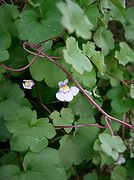- Cymbalaria muralis
-
Cymbalaria muralis 
Scientific classification Kingdom: Plantae (unranked): Angiosperms (unranked): Eudicots (unranked): Asterids Order: Lamiales Family: Scrophulariaceae Genus: Cymbalaria Species: C. muralis Binomial name Cymbalaria muralis
G.Gaertn., B.Mey. & Scherb.Synonyms Linaria cymbalaria
Cymbalaria muralis (Ivy-leaved toadflax or Kenilworth Ivy) is a flowering plant native to Mediterranean Europe and widely naturalised elsewhere. It spreads quickly, growing up to 5 cm (2.0 in) tall—it commonly grows in rock and wall crevices, and along footpaths. The leaves are evergreen, rounded to heart-shaped, 2.5 to 5 cm (0.98 to 2.0 in) long and wide, three-seven lobed, alternating on thin stems. The flowers are very small, similar in shape to snapdragon flowers.[1]
This plant has an unusual method of propagation. The flower stalk is initially positively phototropic and moves towards the light—after fertilization it becomes negatively phototropic and moves away from the light. This results in seed being pushed into dark crevices of rock walls, where it is more likely to germinate and where it prefers to grow.[2]
Gallery
Notes
External links

This Scrophulariaceae article is a stub. You can help Wikipedia by expanding it.



